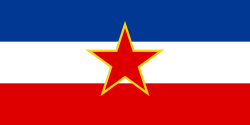Југословени у Србији Jugosloveni u Srbiji | |
|---|---|
| Total population | |
| 27,143 (2022 census)[1] | |
| Regions with significant populations | |
| 12,438[2] | |
| 10,499[2] | |
| Languages | |
| Serbo-Croatian | |
| Religion | |
| Atheism, Eastern Orthodoxy, Catholicism, Islam | |
| Part of a series on |
| Yugoslavs |
|---|
 |
| By region |
| Culture |
| History |
| Languages |
| People |
|
| Ethnicities |
Yugoslavs in Serbia refers to a community in Serbia that view themselves as Yugoslavs with no other ethnic self-identification. Additionally, there are also Serbs, Croats, Montenegrins, Bosniaks, and people of other ethnicities in Serbia who identify themselves as Yugoslavs in a broader sense. However, the latter group does not consider itself to be part of a Yugoslav ethnicity, which is the way the first group identifies itself. According to data from the 2022 census, 27,143 people or 0.4% of population of Serbia (excluding Kosovo) declared their ethnicity as exclusively Yugoslav.[1]
Ahead of the 2022 census, a newly formed organization called National Movement "Yugoslavs" (Narodni pokret “Jugosloveni”)[3] began campaigning to citizens of Serbia to freely self-identify as Yugoslavs, an initiative joined by a number of public figures. One of them is a radio host Daško Milinović, who also announced that work is underway for establishing the National Council of Yugoslavs in Serbia for self-identifying Yugoslavs to enjoy equal ethnic minority rights.[4][5] According to Milinović, Yugoslavs are a community not in an ethnic sense but a community of common values.[5] Among the younger generations who never lived in former Yugoslavia, identifying as Yugoslav tends to be due to their multi-ethnic background but also in protest against nationalism.[6]
Demographics
[edit]People declaring themselves as Yugoslavs are largely concentrated in Vojvodina and Belgrade, where some 85% of all Yugoslavs in Serbia are to be found.
| Year | Population | Share |
|---|---|---|
| 1971[7] | 123,824 | 1.4% |
| 1981[8] | 441,941 | 4.7% |
| 1991[9][10] | 323,643 | 3.3% |
| 1991 (excl. Kosovo)[11][12] | 320,186 | 4.1% |
| 2002 (excl. Kosovo)[13] | 80,721 | 1.1% |
| 2011 (excl. Kosovo)[14] | 23,303 | 0.3% |
| 2022 (excl. Kosovo)[1] | 27,143 | 0.4% |
| Region | Population | Share |
|---|---|---|
| Vojvodina | 12,438 | 0.7% |
| Belgrade | 10,499 | 0.6% |
| Šumadija and Western Serbia | 2,327 | 0.1% |
| Southern and Eastern Serbia | 1,879 | 0.1% |
Notable people
[edit]- Lepa Brena[15] (born 1960), singer, Bosnian Muslim parentage
- Oliver Dulić[16] (born 1975), politician, of mixed Serb and Bunjevac parentage[17]
- Predrag Ejdus, actor, of mixed Jewish and Serb parentage
References
[edit]- ^ a b c "Final results of the Census of Population, Households and Dwellings, 2022". Statistical Office of the Republic of Serbia. 28 April 2023. Retrieved 28 April 2023.
- ^ a b "Population by ethnicity, by areas" (PDF). Retrieved 2023-12-07.
- ^ Bugarin, Aleksandar (30 July 2022). "Narodni pokret "Jugosloveni" – jugoslovenstvo može biti katarza za zla počinjena u ratovima devedesetih" [National Movement "Yugoslavs" - Yugoslavia can be a catharsis for the evils committed in the wars of the 1990s]. Autonomija - Portal Građanske Vojvodine (in Serbo-Croatian). Retrieved 2 October 2022.
- ^ Stilin, B. (2 October 2022). "Krenula kampanja: Sve veći broj javnih osoba nagovara građane da se izjasne kao Jugoslaveni" [A campaign has started: An increasing number of public figures are persuading citizens to declare themselves as Yugoslavs]. tportal.hr (in Serbo-Croatian). Retrieved 2 October 2022.
- ^ a b Latas, A (30 April 2023). "Sve više Jugoslovena u Srbiji, u Novom Sadu ih čak 30 odsto više: Podnose zahtev za registraciju svog Nacionalnog saveta" [More and more Yugoslavs in Serbia, even 30 percent more in Novi Sad: They are applying for the registration of their National Council]. Danas (in Serbo-Croatian). Retrieved 5 May 2023.
- ^ Sovilj, Miodrag (22 May 2023). "'Future Yugoslavs' Emerge In Serbia To Resist Nationalism". Barron's. Agence France-Presse (AFP News). Retrieved 22 May 2023.
- ^ "Popis stanovništva 1971" [1971 Census] (PDF). Republika Srbija - Republički zavod za statistiku. Retrieved 8 October 2022.
- ^ "Popis stanovništva 1981" [1981 Census] (PDF). Republika Srbija - Republički zavod za statistiku. Retrieved 8 October 2022.
- ^ Yugoslav law / Droit yougoslave. Vol. 18–20. Belgrade, Serbia: Union of Jurists' Associations of Yugoslavia. 1991. p. 13. ISSN 0350-2252. OCLC 4291924.
- ^ Lukan, Walter (2006). Serbien und Montenegro: Raum und Bevölkerung, Geschichte, Sprache und Literatur, Kultur, Politik, Gesellschaft, Wirtschaft, Recht [Serbia and Montenegro: space and population, history, language and literature, culture, politics, society, economy, law] (in German). LIT Verlag Münster. p. 56. ISBN 9783825895396.
- ^ Yugoslav law / Droit yougoslave. Vol. 18–20. Belgrade, Serbia: Union of Jurists' Associations of Yugoslavia. 1991. p. 13. ISSN 0350-2252. OCLC 4291924.
- ^ Lukan, Walter (2006). Serbien und Montenegro: Raum und Bevölkerung, Geschichte, Sprache und Literatur, Kultur, Politik, Gesellschaft, Wirtschaft, Recht [Serbia and Montenegro: space and population, history, language and literature, culture, politics, society, economy, law] (in German). LIT Verlag Münster. p. 56. ISBN 9783825895396.
- ^ "Попис становништва, домаћинстава и станова 2011. у Републици Србији" [2011 Census of population, households and apartments in the Republic of Serbia] (PDF). Republika Srbija - Republički zavod za statistiku. 29 November 2012. p. 8. Archived from the original (PDF) on 26 March 2017. Retrieved 8 October 2022.
- ^ "Национална припадност, Попис 2011" [2011 Census, national affiliation]. Archived from the original on 19 November 2015. Retrieved 8 October 2022.
- ^ "Lepa Brena: Nisam ni Hrvatica ni Srpkinja, ja sam Jugoslavenka!" [Lepa Brena: I am neither Croatian or Serbian, I am Yugoslav!]. Index.hr. 8 August 2008.
- ^ "Dulić: 'Nisam Hrvat nego Jugoslaven'". 2007-05-23. Archived from the original on 2007-05-25. Retrieved 2016-03-05.
- ^ Dobio ime po Dragojevicu[permanent dead link]
External links
[edit]- Yugoslav club in Serbia Archived 2018-04-07 at the Wayback Machine